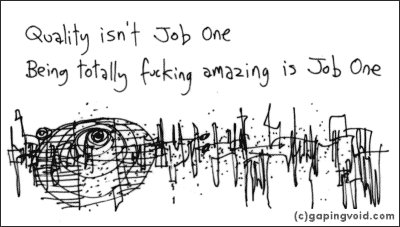 Why do business cards still exist? We can just email (or IM or Twitter or bookmark or tumblelog . . . ) the information around.
Why do business cards still exist? We can just email (or IM or Twitter or bookmark or tumblelog . . . ) the information around.
For example, dear reader, you don’t need my business card—you can just bookmark the blog on de.lioci.us (and gosh, you should!), then log in and hit "contact" whenever you want to reach me.
What’s easy to forget is that 92% of the world still doesn’t work this way. No matter how wired you are, you probably still meet people in meatspace. Especially those adorable creatures, your potential customers.
So we probably still need business cards, but maybe they don’t need to suck. Here are two cheap, easy, and non-sucking possibilities.
Gaping Void
Hugh MacLeod has the career I want. He also has the talent I want, wrapped in a deliciously bitter but somehow uncynical wrapper. He’s mostly known as a cartoonist, but he’s much more than that. I see him more as a back-of-the-business-card philosopher.
If you don’t know his stuff, run over there and spend a few hours immersed it it. And when you come up for air, notice that he has a link to create blog cards with his designs.
Blog cards can be business cards and vice versa. Robert Scoble is rumored to carry a Gaping Void card, but don’t let that stop you. You can put up to ten lines on the back of one 72 possible designs. Some of the Gaping Void designs are "safe," some aren’t.
Gaping Void’s blog cards are the Nick Cave of business cards. They say, "I’m intelligent and non-obvious. My psychic pain does not keep me from getting stuff done. I might think you’re an utter wanker, but you should hire me anyway."
moo cards have a very different vibe. They’re just plain . . . cute. They’re about half the size of a regular business card, and you can use dozens of different images in the same run of cards if you like. (Handy if you have customers in different fields—you can pick fresh-baked cinnamon rolls for your foodie clients and interesting technical bits for a more geek-friendly look.) They have an good set of Flickr images you can choose from, or you can upload your own.
I’m using moo cards right now, with the image at the top of this section. moo works beautifully for my small-business clients. moo cards are friendly and nonthreatening. They’re different enough to draw attention, without being so different that they scare anybody. They’re the Japanese school girl of business cards. These cards say "I’m nice, I’m easy to work with, and I’ll take a fresh look at things."
A business card is the first step on a path
Listing every possible way to contact you is soooooo 2003. Remember the principle of The Big Red Fez—decide on the one click (or action) that you want people to take, and make it easy to do that.
I’m thinking about creating two sets of cards—Gaping Void cards for the less traditional recipient, moo for the more so. The Gaping Void cards will probably just have two lines—remarkable communication and the blog address. My next set of moo will get the business name, the blog, the static site, my email address, and my name.
Here’s the GV card I’m thinking of—what do you think?

One more thought—get cards that don’t cost much. You never know what you’re going to invent tomorrow. The next gateway you create might be a Squidoo lens, a tumblelog, a YouTube video. A business card is just one of many initial stepping stones. Stay flexible, find a piece that communicates the right message, and of course, always be remarkable.
(P.S. Yes, I know Seth already did this post—but damn it, I already had this one drafted when he did his. And I’ve wanted to use the GV stuff for ages.)


Business cards don’t have to suck, but they frequently do. I am putting one together that will have a Semacode for my blog on the back. Soon, all sorts of devices will be able to read them and shoot someone straight to your web ID. I also registered my own name with .com, .net, and .org. Shortly that site will be an online business card and “CV”.
I needed to read something like this this morning – thank you for having it ready for my enjoyment.